|

Introduction
We've talked recently about the
roadmaps for high refresh rate displays and panels in the monitor market, spanning
across various panel technologies and screen sizes. One interesting sector was in
the TN Film market where high refresh rate screens of 120Hz and 144Hz have been
available for many years, originally being the only choice in the LCD monitor
market for high frame rate gaming. While other panel technologies like IPS and
VA have more recently ventured in to the 120Hz/144Hz refresh rate market
themselves, TN Film is again pushing the boundaries this year with the arrival
of native 240Hz refresh rate support. This doubles the potential frame rate
support from the original 120Hz panels from many years ago, going back to 2009
in fact. If you refer to the previously mentioned roadmap article you will see
that it is AU Optronics who, as a panel manufacturer, are pushing the refresh
rate for this new generation of TN Film panel, with options being produced in
24.5" and 27" sizes. The first to go in to production was the 24.5" panel
variants which have quickly been adopted by some of the main gaming display
manufacturers. Acer, Asus, BenQ and AOC have all got equivalent 24.5" models
(often referenced as 25" in size for ease) coming out to compete in the ever-popular
gamers sector.
We have with us now the first European sample of
AOC's version of this screen, their AGON AG251FZ display. This is part of their
AGON branded gaming line-up of screens and this 24.5" model offers some
impressive gaming features including the aforementioned 240Hz native refresh
rate, along with a 1ms G2G response time and AMD FreeSync support. The other
models from Acer, Asus and BenQ are all NVIDIA G-sync compatible so at the time
of writing this is the only FreeSync option using this new panel.
If you appreciate the review and enjoy reading and like our work, we would welcome a
donation
to the site to help us continue to make quality and detailed reviews for you.
|
Check Pricing and Buy - Direct Links
|
|
Amazon
|
|
TFTCentral is a participant
in the Amazon Services LLC Associates Programme, an affiliate
advertising programme designed to provide a means for sites to earn
advertising fees by advertising and linking to Amazon.com, Amazon.co.uk,
Amazon.de, Amazon.ca and other Amazon stores worldwide. We also
participate in a similar scheme for Overclockers.co.uk. |

Specifications and Features
The following table gives detailed information
about the specs of the screen:
|
Monitor
Specifications |
|
Size |
24.5"WS |
Panel Coating |
Medium AG coating |
|
Aspect Ratio |
16:9 |
Interfaces |
1x DisplayPort
(version 1.2a), 2x HDMI (MHL), 1x VGA, 1x DL-DVI, 4x USB 3.0
|
|
Resolution |
1920 x 1080 |
|
Pixel Pitch |
0.2825 mm |
Design
colour |
Matte black plastic bezel, silver stand and
base and dark red trim on the back |
|
Response Time |
1ms G2G |
Ergonomics |
Tilt, 130mm height, swivel, rotate |
|
Static Contrast Ratio |
1000:1 |
|
Dynamic Contrast Ratio |
50 million:1 |
VESA Compatible |
Yes 100mm |
|
Brightness |
400 cd/m2 |
Accessories |
Power cable and brick, DisplayPort, DVI, VGA, HDMI,
audio, USB cables |
|
Viewing Angles |
170 / 160 |
|
Panel Technology |
AU Optronics TN Film |
Weight |
with stand: 6.5 Kg |
|
Backlight Technology |
W-LED |
Physical Dimensions |
(WxHxD)
566.65 x 545.21 x 218.25 mm |
|
Colour Depth |
16.7m (6-bit + FRC) |
|
Refresh Rate |
240Hz native
FreeSync range 48 - 240Hz |
Special
Features |
4x
USB 3.0 ports (1 with charging), audio/headphone/mic connections, AMD
FreeSync, headphone holding arm, 2x 3W speakers, switch accessory |
|
Colour Gamut |
Standard gamut
sRGB, ~72% NTSC |
The AG251FZ offers a very good range of connectivity
options with DisplayPort 1.2a, 2x HDMI (one with MHL), 1x Dual-link DVI and 1x
VGA connections
offered. DisplayPort or HDMI are needed to support the refresh rate up to 240Hz, including FreeSync support from compatible
AMD graphics cards via DP (48 - 240Hz range).
The digital interfaces are HDCP certified for encrypted content and the video
cables are provided in the box for all four video connections.
The screen has an external power supply and comes
packaged with the power cable and power brick you need. There are also 4x USB 3.0 ports
available with 2 located
on the back of the screen with the video connections, and 2 on the right hand
side of the screen for easy access - with one have fast charging
capabilities as well. A headphone jack and mic input are also provided on the
right hand side of the screen, while the back of the screen also has an audio
output and an alternative mic input. There are integrated 2x 3W stereo speakers
on this model as well.
Below is a summary of the features and connections
of the screen:
|
Feature |
Yes / No |
Feature |
Yes / No |
|
Tilt adjust |
 |
DVI |
 |
|
Height adjust |
 |
HDMI |
 |
|
Swivel adjust |
 |
D-sub |
 |
|
Rotate adjust |
 |
DisplayPort |
 |
|
VESA compliant |
 |
Component |
 |
|
USB 2.0 Ports |
 |
Audio connection |
 |
|
USB 3.0 Ports |
 |
HDCP Support |
 |
|
Card Reader |
 |
MHL Support |
 |
|
Ambient Light Sensor |
 |
Integrated Speakers |
 |
|
Human Motion Sensor |
 |
PiP / PbP |
 |
|
Touch Screen |
 |
Blur Reduction Mode |
 |
|
Factory calibration |
 |
G-Sync |
 |
|
Hardware calibration |
 |
FreeSync |
 |
|
Uniformity correction |
 |
Wireless charging |
 |

Design and Ergonomics
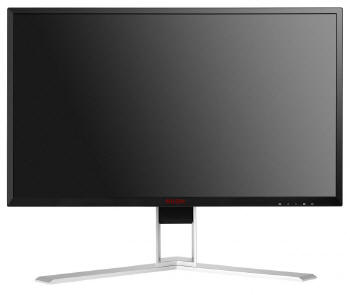
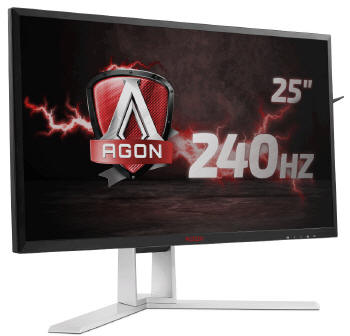
Above: front views of the screen and stand. Click for larger versions
The AG251FZ comes in a black and silver design
with defined edges and straight lines. The bezel around the screen is matte
black in finish with a plastic which has a brushed (black colour) aluminium
style along the bottom edge. There is an AG251FZ label in the top right hand
corner in a subtle dark grey colour and a dark red "AGON" brand in the middle of
the lower bezel. In the bottom right hand corner are small, subtle light grey
labels for the OSD controls and a small power LED. This glows white during
normal operation. The OSD control buttons themselves are located on the bottom
edge of the screen out of sight, but they are easy to find thanks to the labels
on the front bezel. The bezel measures only 10mm along the sides and top, and is
a little thicker at 17mm along the bottom edge.
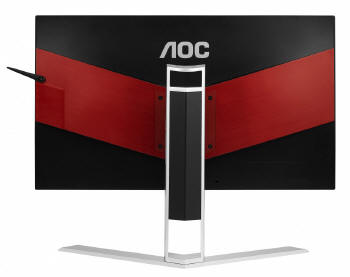
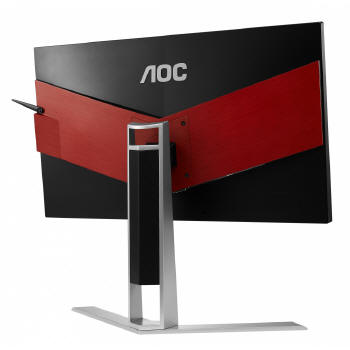
Above: rear
views of the screen. Click for larger versions
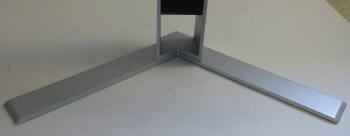
Above: view
of the stand base. Click for larger versions
The back of the screen is finished with a matte
black plastic and a dark red plastic section as shown in the photos above. There
is a silver coloured AOC logo on the back and the stand attaches in the middle.
This needs to be screwed on to the screen when you first unpack it from the box.
A word of warning, it took us a while to find the proper screws to attach the
stand, but they were taped to the polystyrene section for the stand. The stand
can be removed to reveal VESA 100mm mounting support if needed. You will notice
that the stand features a useful carry handle at the top for moving the screen
round or taking it to LAN parties. You will also notice the small protruding
clip on the left of these images. That is a headphone holder clip which can be
swung up and down when needed (i.e. it's not always out like the pictures
show!). The base of the stand is a silver metal finish and provides a wide and
sturdy base for the display.
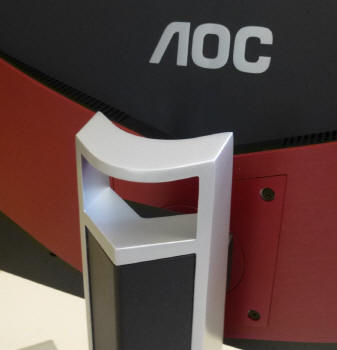
Above:
rear view showing carry handle
and VESA mounting section. Click for larger version
The display has a nice thin side profile thanks to the use of a W-LED backlight unit and an external
power supply.
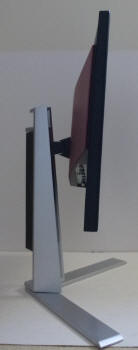
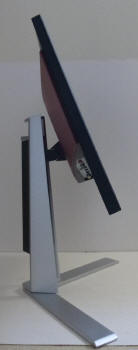
Above: full
tilt range of the screen shown. Click for larger versions
The screen offers a full range of tilt, height,
swivel and rotate adjustments from
the stand. The screen remains stable on the desk with no wobbling which is
pleasing. Tilt is smooth and relatively easy
to use and offers a nice wide range of adjustment as shown above.
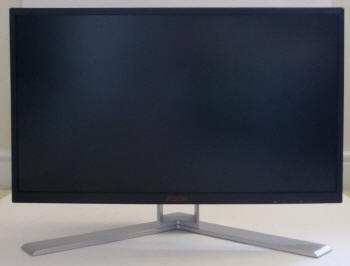
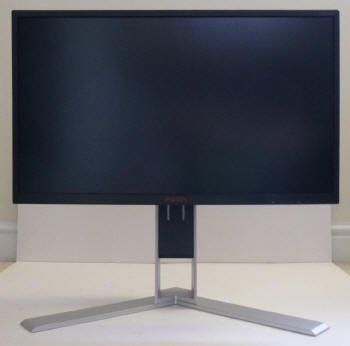
Above: full
height adjustment range of the screen shown. Click for larger versions
Height adjustment is also available with
smooth movement but is a little stiff to move. At the
lowest setting the bottom edge of the screen is ~80mm from the top of the
desk, and at maximum extension it is ~200mm. This gives a total adjustment
range of ~120mm which is decent.
Side to side swivel is smooth and easy to
use and offers a decent enough adjustment range. The rotation function is
a bit "bumpy" and stiff to operate, but is at least available for those
who might want to use it.
A summary of the ergonomic adjustments
are shown below:
|
Function |
Range |
Smoothness |
Ease of Use |
|
Tilt |
Yes |
Smooth |
Quite easy |
|
Height |
120mm |
Smooth |
Quite easy |
|
Swivel |
Yes |
Smooth |
Easy |
|
Rotate |
Yes |
Bumpy |
Stiff |
|
Overall |
Full range of adjustments
which are mostly easy to use. Stable and sturdy stand. |
The materials were of a good standard and the
build quality felt good as well. There was no audible noise from the screen,
even when conducting specific tests which can often identify buzzing issues.
The whole screen remained cool even during prolonged use as well which
was pleasing.
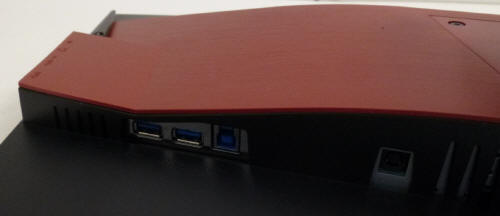

Above:
interface connections on the back. Click for larger versions
The back of the screen features the interface
connections as shown above. On the left hand side of the screen (shown in the
top picture) there are 2x USB downstream and 1x USB upstream ports. There is
also the power connection towards the middle of the screen. On the right hand
side of the screen (shown in the bottom picture) there are the video and audio
connections. There are 1x DL-DVI, 2x HDMI, 1x DisplayPort, 1x D-sub VGA, an
audio out, microphone input jack and the small connection for the remote
accessory (see below).
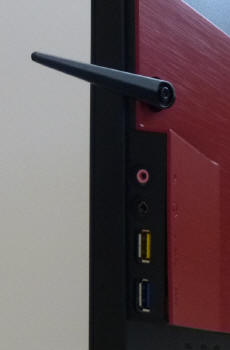
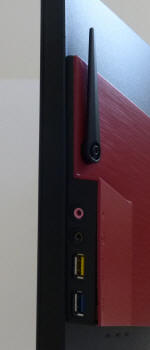
Above:
connections on the right hand side of the screen. Click for larger versions
The right hand side of the screen offers a few
easy access connections. There is the headphone hanger clip at the top as shown,
then an additional mic input, headphone jack output and 2x USB ports, one with
fast charging capability. It's useful to have these available for easy access on
the side of the screen, especially for gaming where you might want to quickly
and easily attach additional devices and headphones/mic.
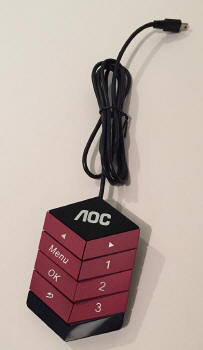
Above:
additional switch accessory. Click for larger version
Provided with the screen is a handy switch
accessory as pictured above. This gives you quick, easy and intuitive control
over the OSD menu as well as some quick access options. Certainly handy for
switching between modes and some key settings for gaming.

OSD Menu

Above: OSD control buttons on the bottom right hand edge of the screen. Click for larger
version
The OSD menu is controlled through a series of
pressable buttons located on the bottom right hand edge of the screen. The
labels for the buttons are on the front bezel, making them easy to find and
identify. There is quick access (from left to right) for the input selection,
game preset mode selection and shadow control slider.

The OSD menu is split in to 7 sections shown
horizontally along the top part of the software. As you scroll left and right
using the corresponding arrow buttons, you are shown which settings are then
available in each section. The first 'luminance' section has the settings for
contrast, brightness and gamma modes along with access to the ECO mode (a series
of preset locked brightness levels) and
dynamic contrast ratio. The second 'image setup' section is greyed out here as
that's for when you connect over VGA, and we are using DisplayPort.

The 'color setup' section has options for the
colour temperature modes and access to the RGB channels for
calibration.

The 'picture boost' section is specifically for
enabling a bright frame section of the screen where the brightness and contrast
can be separately controlled for that frame. You can adjust the size and
location of the frame as well.

The 'OSD setup' section allows you to adjust the
OSD software itself.

The 'game setting' section has some useful options
available. There is access to the game preset modes, the shadow control slider,
the low input lag setting, the slider to boost the game colour, the low blue
light modes (not really a gaming setting) and the
overdrive control.

The final 'extra' section has a few options for
the input selection and off timer but not much else.
Overall there was a very good range of options
available from the menu. Navigation via the OSD buttons felt a bit fiddly though
and the software was a little laggy as you move between sections. This was
actually linked to your active refresh rate it seems, with a much bigger lag
when running at 60Hz than the high refresh rate options. Drilling then in to
each section and option was a bit of a pain. The software did at least remember
which section you were last for in for a while when you go back in to the menu
which was useful. The additional switch accessory made the whole thing quite a
lot easier though and we liked having that available.

Power Consumption
In terms of power consumption the manufacturer
lists typical 'on' usage as TBC but do at least list 0.5W usage in standby. We carried out our normal tests to
establish its power consumption ourselves.
|
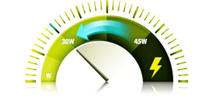 |
|
State and Brightness
Setting |
Manufacturer Spec (W) |
Measured Power Usage
(W) |
|
Default (90%) |
TBC |
24.4 |
|
Calibrated (21%) |
- |
17.2 |
|
Maximum Brightness (100%) |
- |
26.7 |
|
Minimum Brightness (0%) |
- |
15.1 |
|
Standby |
0.5 |
1.4 |
|
We tested this ourselves and found that out of the
box the screen used 24.4W at the default 90% brightness setting. Once calibrated the screen reached
17.2W consumption, and in standby it
used only 1.4W. We have plotted these results below compared with other screens
we have tested. The consumption is comparable to the other
screens in this 24 - 25" size range we have tested as you might expect (comparing the calibrated states).


Panel and Backlighting
|
Panel Manufacturer |
AU Optronics |
Colour Palette |
16.7 million |
|
Panel Technology |
TN Film |
Colour Depth |
6-bit + FRC |
|
Panel Module |
M250HTN01.0 |
Colour space |
Standard gamut |
|
Backlighting Type |
W-LED |
Colour space coverage (%) |
sRGB, ~72% NTSC |
Panel Part and Colour Depth
The screen features an
AU Optronics M250HTN01.0 TN Film technology panel which is capable of producing
16.7 million colours. This is achieved through a 6-bit colour depth with
additional Frame Rate Control (FRC) added. The
panel part is confirmed when dismantling the screen as shown below:
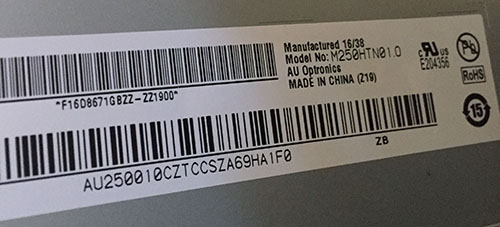
Screen
Coating
The
screen coating is a medium anti-glare (AG) offering. It isn't a semi-glossy
coating, and isn't as light as some modern IPS type panels either. It's in
keeping with other TN Film panels we've tested. Thankfully it isn't a heavily
grainy coating like some old IPS panels feature, although there is some
graininess noticeable. It retains its anti-glare properties to avoid too many
unwanted reflections of a full glossy coating, but does not produce an too
grainy or dirty an image that some thicker AG coatings can. There were some
slight cross-hatching patterns visible on the coating as well but only if you
looked very closely.
Backlight Type and Colour Gamut
The screen uses a White-LED (W-LED) backlight unit
which is standard in today's market. This helps reduce power consumption
compared with older CCFL backlight units and brings about some environmental
benefits as well. The W-LED unit offers a standard colour gamut which is
approximately equal to the sRGB colour space. Anyone wanting to work with wider colour spaces would need to consider
wide gamut CCFL screens or the newer range of GB-r-LED type (and similar)
displays available now. If you want to read more about colour spaces and gamut
then please have a read of our
detailed article.
Backlight
Dimming and Flicker
We tested the screen to establish the methods used
to control backlight dimming. Our in depth article talks in more details about a
common method used for this which is called
Pulse Width Modulation (PWM). This in itself gives cause for concern to some
users who have experienced eye strain, headaches and other symptoms as a result
of the flickering backlight caused by this technology. We use a photosensor +
oscilloscope system to measure backlight dimming control
with a high level of accuracy and ease. These tests allow us to establish
1) Whether PWM is being used to control the
backlight
2) The frequency and other characteristics at which this operates, if it is used
3) Whether a flicker may be introduced or potentially noticeable at certain
settings
If PWM is used for backlight dimming, the higher
the frequency, the less likely you are to see artefacts and flicker. The duty
cycle (the time for which the backlight is on) is also important and the shorter
the duty cycle, the more potential there is that you may see flicker. The other
factor which can influence flicker is the amplitude of the PWM, measuring the
difference in brightness output between the 'on' and 'off' states. Please
remember that not every user would notice a flicker from a backlight using PWM,
but it is something to be wary of. It is also a hard thing to quantify as it is
very subjective when talking about whether a user may or may not experience the
side effects.
100% 50%
0%
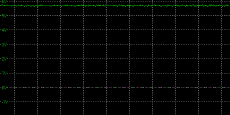
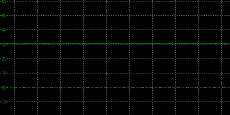
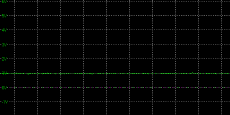
Above scale = 1
horizontal grid = 5ms
At 100% brightness a constant voltage is applied
to the backlight. As you reduce the brightness setting to dim the backlight a
Direct Current (DC) method is used, as opposed to any form of PWM. This applies
to all brightness settings from 100% down to 0%. The screen is flicker free as a
result which is great news.
|
Pulse Width
Modulation Used |
No |
|
Cycling
Frequency |
n/a |
|
Possible
Flicker at |
|
|
100% Brightness |
No |
|
50% Brightness |
No |
|
0% Brightness |
No |

Contrast
Stability and Brightness
We wanted to see how much variance there was in
the screens contrast as we adjusted the monitor setting for brightness.
In theory, brightness and contrast are two independent parameters, and good
contrast is a requirement regardless of the brightness adjustment.
Unfortunately, such is not always the case in practice. We recorded the
screens luminance and black depth at various OSD brightness settings, and
calculated the contrast ratio from there. Graphics card settings were left at
default with no ICC profile or calibration active. Tests were made using an
X-rite i1 Display Pro colorimeter. It should be noted that we used the
BasICColor calibration software here to record these, and so luminance at
default settings may vary a little from the LaCie Blue Eye Pro report.
|
OSD
Brightness |
Luminance
(cd/m2) |
Black
Point (cd/m2) |
Contrast
Ratio
( x:1) |
|
100 |
365.74 |
0.39 |
938 |
|
90 |
296.27 |
0.32 |
926 |
|
80 |
270.33 |
0.29 |
932 |
|
70 |
244.30 |
0.26 |
940 |
|
60 |
219.33 |
0.23 |
954 |
|
50 |
192.79 |
0.21 |
918 |
|
40 |
165.89 |
0.18 |
922 |
|
30 |
140.17 |
0.15 |
934 |
|
20 |
112.70 |
0.12 |
939 |
|
10 |
84.86 |
0.09 |
943 |
|
0 |
58.28 |
0.06 |
971 |
|
Total Luminance Adjustment Range
(cd/m2) |
307.46 |
Brightness OSD setting controls backlight? |
 |
|
Total Black Point
Adjustment Range (cd/m2) |
0.33 |
|
Average Static Contrast Ratio |
938:1 |
PWM Free? |
 |
|
Recommended OSD setting
for 120 cd/m2 |
23 |
We conducted these tests in the default settings. The brightness control gave us a
very good range of adjustment. At the top end the maximum luminance reached 366
cd/m2 which was
a little shy of the specified maximum brightness of 400 cd/m2
from the manufacturer but still more than adequate we're sure. There was a good
307 cd/m2 adjustment range
in total, and so at the minimum setting you could reach down to a low luminance
of 58 cd/m2. This should be adequate for those wanting to
work in darkened room conditions with low ambient light. A setting of 23 in the OSD menu should return you a
luminance of around 120 cd/m2 at default settings in this preset mode.
It should be noted that the
brightness regulation is controlled without the need for
Pulse Width Modulation, using a Direct Current (DC) method for all
brightness settings between 100 and 0% and so the screen is flicker free.
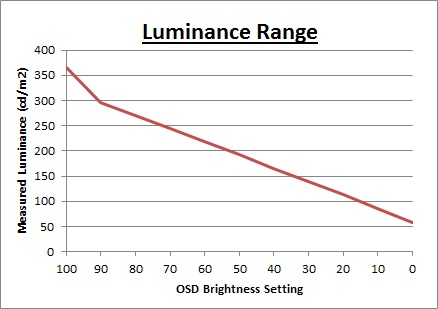
We have plotted the
luminance trend on the graph above. The screen behaves as it should in this
regard, with a reduction in the luminance output of the screen controlled by the
reduction in the OSD brightness setting. This is not a linear relationship as
adjustments between 100 and 90 control a steeper luminance range, but this
becomes linear from 90 to 0.
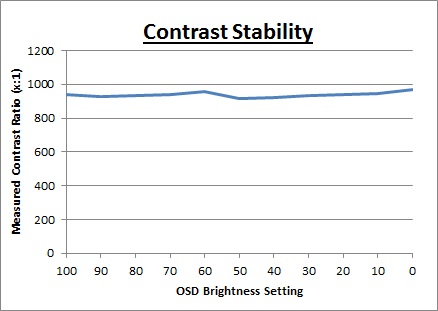
The average contrast ratio of
the screen was good for a TN Film panel at 938:1. This was pretty stable
across the brightness adjustment range as shown above.

Testing
Methodology
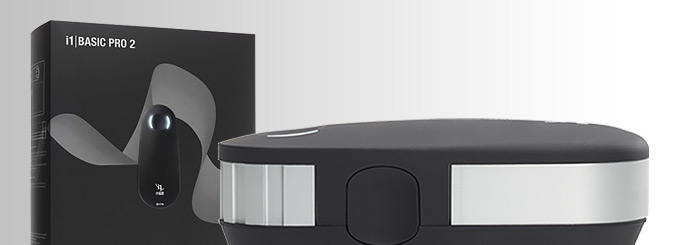
An
important thing to consider for most users is how a screen will perform out of
the box and with some basic manual adjustments. Since most users won't have
access to hardware colorimeter tools, it is important to understand how the
screen is going to perform in terms of colour accuracy for the average user.
We restored our graphics card to default settings
and disabled any previously active ICC profiles and gamma corrections. The
screen was tested at default factory settings using our new
X-rite i1
Pro 2 Spectrophotometer combined with
LaCie's Blue Eye Pro software suite. An X-rite i1 Display Pro colorimeter was
also used to verify the black point and contrast ratio since the i1 Pro 2
spectrophotometer is less
reliable at the darker end.
Targets for these tests are as follows:
-
CIE Diagram - validates the colour space
covered by the monitors backlighting in a 2D view, with the black triangle representing the
displays gamut, and other reference colour spaces shown for comparison
-
Gamma - we aim for 2.2 which is the default
for computer monitors
-
Colour temperature / white point - we aim
for 6500k which is the temperature of daylight
-
Luminance - we aim for 120
cd/m2, which is
the recommended luminance for LCD monitors in normal lighting conditions
-
Black depth - we aim
for as low as possible to maximise shadow detail and to offer us the best
contrast ratio
-
Contrast ratio - we aim
for as high as possible. Any dynamic contrast ratio controls are turned off here
if present
-
dE average / maximum -
as low as possible.
If DeltaE >3, the color displayed is significantly different from the
theoretical one, meaning that the difference will be perceptible to the
viewer.
If DeltaE <2, LaCie considers the calibration a success; there remains a
slight difference, but it is barely undetectable.
If DeltaE < 1, the color fidelity is excellent.

Default Performance and
Setup
Default settings of the screen were as follows:
|
Monitor OSD Option |
Default Settings |
|
Game preset mode |
Off |
|
Brightness |
90 |
|
Contrast |
50 |
|
Gamma |
1 |
|
Color Temp |
Warm |
|
RGB |
(locked) 50, 47, 44 |

AOC AGON AG251FZ- Default Settings, Gamma mode 1



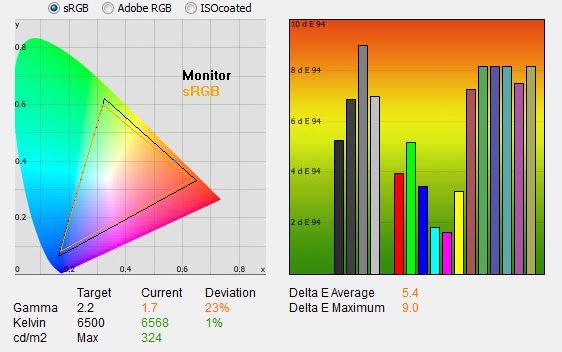

|
|
Default Settings |
|
luminance (cd/m2) |
324 |
|
Black Point (cd/m2) |
0.35 |
|
Contrast Ratio |
924:1 |
Initially out of the box the screen was set in the
default gamma mode 1 and with the game preset modes turned off. With a very high
default 90% brightness setting out of the box the screen was overly bright and
uncomfortable to use, so you will definitely need to turn that down. You could
tell the screen was using a standard gamut backlight as well with the naked eye,
and the colour balance and temperature felt pretty good, although the image did
appeared quite washed out, as if gamma was a long way off the usual 2.2 target.
We went
ahead and measured the default state with the i1 Pro 2. The
CIE diagram on the left of the image confirms that the monitors colour gamut
(black triangle) is fairly equal to
the sRGB colour space. There is some modest over-coverage in greens but not by
anything too significant. Default gamma was recorded at 1.7 average in this
gamma 1 mode, leaving it with a significant 23% deviance
from the target which was a potential issue. Remember this is a gaming screen,
where a low gamma like this is often desirable for gaming uses. There are a
couple of other gamma settings in the OSD menu which we will test in a moment,
so don't be too worried. White
point was measured at an accurate 6568k, being only 1%
out from the 6500k we'd ideally want for desktop use. Note that the default 'color
temp' preset was set to 'warm' here which was actually about right for our
targets.
Luminance was recorded at a very bright 324
cd/m2 which is
far too high for prolonged general use. The screen was set at a default 90%
brightness in the OSD menu but that is easy to change of course to reach a more
comfortable setting without impacting any other aspect of the setup. The black
depth was 0.35 cd/m2 at this default
brightness setting, giving us a decent (for an TN Film panel) static contrast ratio of
924:1.
Colour accuracy was pretty very poor out of the box
because of the very low gamma here, with an average dE of 5.4 measured. Testing the screen with colour
gradients showed smooth transitions in all shades, with some slight gradation evident
in darker tones.
Overall this default setup was aimed at gaming,
where the low gamma was desirable. There was at least a reliable white point but
you would certainly need to turn the brightness down a lot to be comfortable. Let us
test the other gamma modes to see if they can return a better setup for more
general day to day use, away from gaming.
|
Monitor OSD Option |
Default Settings |
|
Game preset mode |
Off |
|
Brightness |
90 |
|
Contrast |
50 |
|
Gamma |
3 |
|
Color Temp |
Warm |
|
RGB |
(locked) 50, 47, 44 |

AOC AGON AG251FZ- Default Settings, gamma mode 3
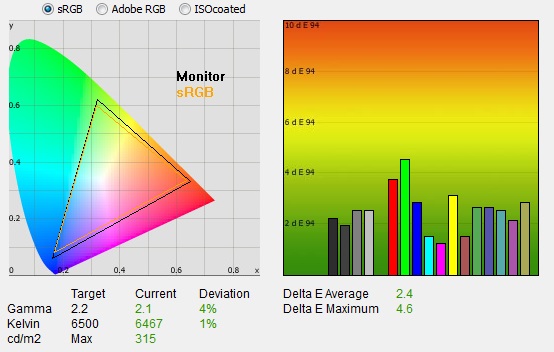

|
|
Default Settings |
|
luminance (cd/m2) |
315 |
|
Black Point (cd/m2) |
0.351 |
|
Contrast Ratio |
898:1 |
A simple change in the OSD menu to gamma mode 3
returned a much better setup for every day non-gaming uses. Note also that the
gamma mode 2 showed very little change to the measured gamma from mode 1 (measuring 1.7
average, 21% deviance). In gamma mode 3, the average gamma was now 2.1 with a
small 4% deviance from our target. White point remained reliable, and now the
colour accuracy was much better with an average dE of 2.4 measured now. Again,
you need to turn down the brightness, and you have a small drop in contrast
ratio because of the gamma adjustment, but this mode represents a much better
setup for normal uses. Thankfully AOC have provided a good gamma adjustment via
the OSD as otherwise that can be very tricky to correct without a hardware
calibration device.

Calibration
We used the
X-rite i1 Pro 2
Spectrophotometer combined with the LaCie Blue Eye Pro software package to
achieve these results and reports. An X-rite i1 Display Pro colorimeter was used
to validate the black depth and contrast ratios due to lower end limitations of
the i1 Pro device.
|
Monitor OSD Option |
Calibrated Settings |
|
Game preset mode |
Off |
|
Brightness |
21 |
|
Contrast |
50 |
|
Gamma |
3 |
|
Color Temp |
User |
|
RGB |
49, 47, 44 |

AOC AGON AG251FZ - Calibrated Settings
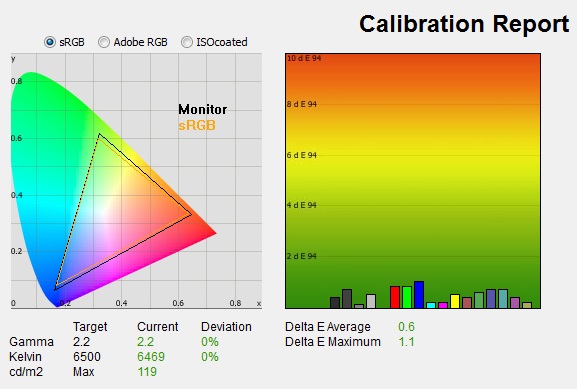

|
|
Calibrated Settings |
|
luminance (cd/m2) |
119 |
|
Black Point (cd/m2) |
0.128 |
|
Contrast Ratio |
931:1 |
We stuck to the gamma mode 3 which had delivered a
more reliable gamma close to 2.2 out of the box, and then also switched to the 'user' color
temp mode. Although we know the default 'warm' preset was very reliable, we
wanted to be able to tweak the RGB channels as necessary during the calibration
process. We adjusted the RGB
channels and brightness setting as shown in the table above. All these OSD
changes allowed us to obtain an optimal hardware starting point and setup before software level changes would be
made at the graphics card level. We left the LaCie software to calibrate
to "max" brightness which would just retain the luminance of whatever brightness
we'd set the screen to, and would not in any way try and alter the luminance at
the graphics card level, which can reduce contrast ratio. These adjustments
before profiling the screen would help preserve tonal values and limit
banding issues. After this we let the software carry out the LUT adjustments and create an
ICC profile.
Average gamma was now corrected to 2.2 average
with a 0% deviance, correcting the minor 4% deviance we'd seen out of the box in
this gamma mode 3. The
white point had now been corrected to 6469k, which largely corrected the minor 1%
deviance we'd seen out of the box. Luminance had been improved thanks to the
adjustment to the brightness control and was now being measured at 119
cd/m2. This
left us a black depth of 0.128 cd/m2 and maintained a decent static
contrast ratio (for a TN Film panel) of
931:1. Colour accuracy of the resulting
profile was excellent, with dE average of 0.6 and maximum of 1.1. LaCie would
consider colour fidelity to be very good overall.
Testing the screen with various colour gradients
showed smooth transitions. There was some slight gradation in darker tones
and some very minor banding introduced due to the adjustments to the
graphics card LUT from the profilation of the screen.
You can use our settings and
try our calibrated ICC profile if you wish, which are available in
our ICC profile database. Keep in mind that results will vary from one
screen to another and from one computer / graphics card to another.

Calibration Performance Comparisons
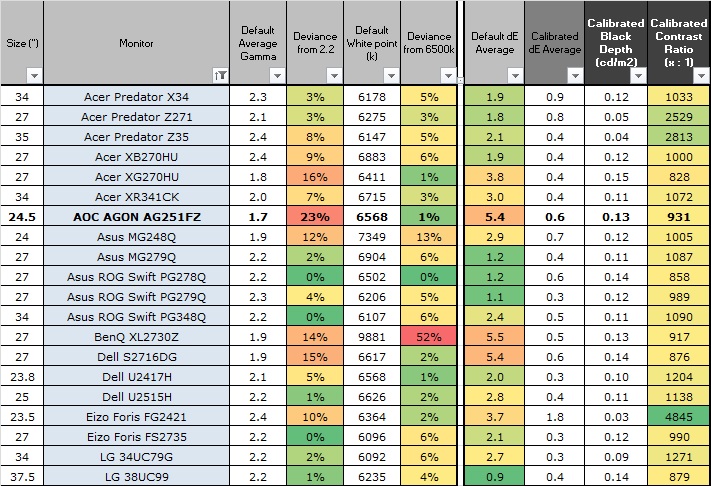
The comparisons made in this section try to give
you a better view of how each screen performs, particularly out of the box which
is what is going to matter to most consumers. When comparing the default factory
settings for each monitor it is important to take into account several
measurement areas - gamma, white point and colour accuracy. There's no point
having a low dE colour accuracy figure if the gamma curve is way off for
instance. A good factory calibration requires all 3 to be well set up. We have
deliberately not included luminance in this comparison since this is normally
far too high by default on every screen. However, that is very easily controlled
through the brightness setting (on most screens) and should not impact the other
areas being measured anyway. It is easy enough to obtain a suitable luminance
for your working conditions and individual preferences, but a reliable factory
setup in gamma, white point and colour accuracy is important and not as easy to
change accurately without a calibration tool.
From these comparisons we can also compare the
calibrated colour accuracy, black depth and contrast ratio. After a calibration
the gamma, white point and luminance should all be at their desired targets.
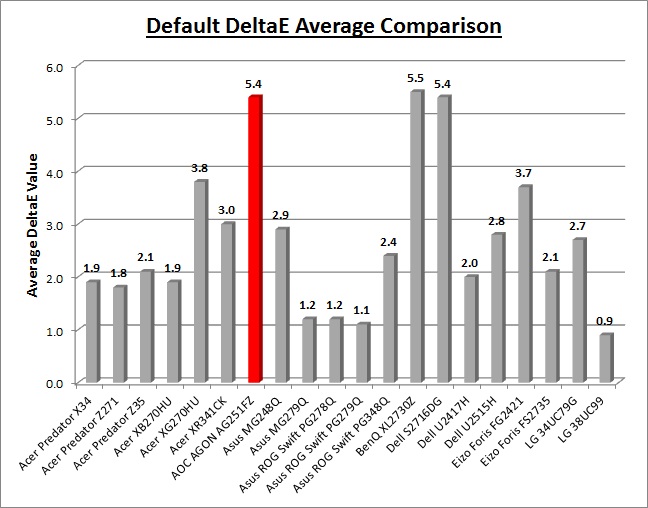
Default setup of the screen out of the box was
very much aimed at gaming requirements and so it's a little unfair perhaps to
judge the screen on this basis. Out of the box, the gamma mode 1 delivered an
average 1.7 gamma which skewed the gamma curve a long way from our desired 2.2,
and had a knock on effect to the dE colour accuracy. The white point was at
least very reliable, and contrast ratio good for a TN Film panel. Thankfully
it's very simple to improve the setup with a change to the gamma mode 3, which
returned a more accurate 2.1 gamma and lower dE of 2.4. It's very common for the
TN Film gaming screens to be set up out of the box with a lower gamma, and you
can see this if you look at the
Acer Predator XG270HU (1.8),
Asus MG248Q (1.9) and
BenQ XL2730Z (1.9) for example. With the better day to day set up being
easily accessible to users via the gamma mode 3, we don't need to penalise the
screen here for its gaming gamma curve at default settings. Had AOC not provided
gamma controls in the menu it would be another story, as the gamma curve can be
very tricky to correct otherwise without access to a hardware calibration
device.
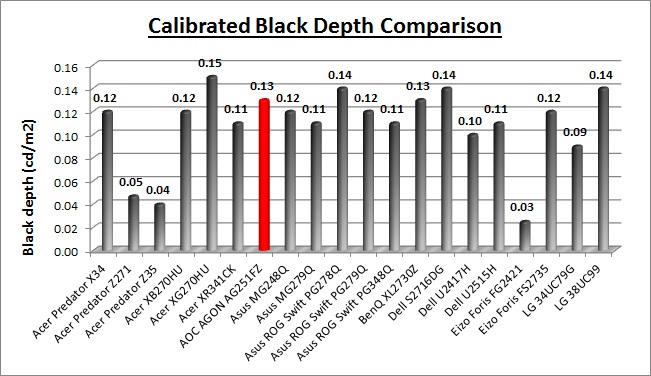
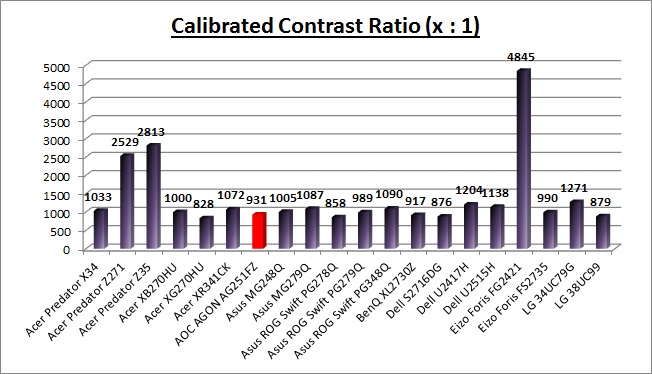
The display was good when it came to static
contrast ratio for a TN Film panel, at 931:1 after calibration. This was similar
to some other high end gaming TN Film screens like the Asus MG248Q (1005:1) and
BenQ XL2730Z (917:1) for instance. Of course
none of these TN Film panels can compete with VA panel types which can reach over 2000:1 easily, and
commonly up to 3000:1 (e.g.
Acer Predator Z35)
or even near 5000:1 (Eizo
Foris FG2421).
|
Check Pricing and Buy - Direct Links
|
|
Amazon
|
|
TFTCentral is a participant
in the Amazon Services LLC Associates Programme, an affiliate
advertising programme designed to provide a means for sites to earn
advertising fees by advertising and linking to Amazon.com, Amazon.co.uk,
Amazon.de, Amazon.ca and other Amazon stores worldwide. We also
participate in a similar scheme for Overclockers.co.uk. |

Viewing Angles
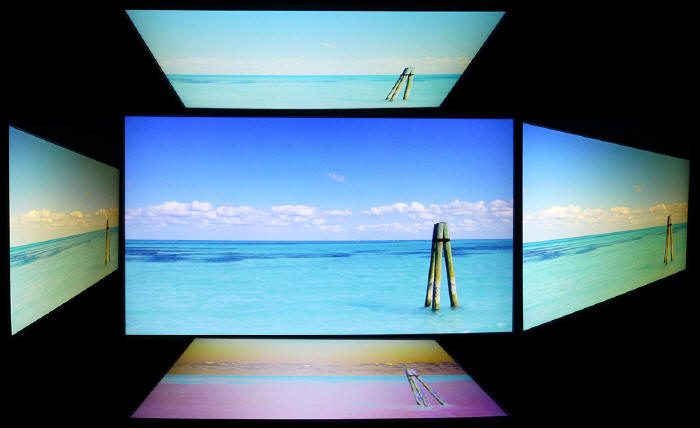
Above: Viewing
angles shown from front and side, and from above and below. Click for
larger image
Viewing angles of the screen were as you might
expect from a TN Film panel. Unfortunately this panel technology is inherently
poor in this field, and so viewing angles are more restrictive than other
competing technologies like IPS and VA variants. Although the manufacturer will
quote a viewing angle of 170 / 160 (a classic indication that a TN Film panel is
being used by the way if in doubt), in practice there are some obvious contrast
and colour tone shifts horizontally, and especially vertically.
As you move your head from side to side in a
horizontal plane, there is a contrast shift and the image becomes more pale and
introduces a yellow hue. As you move to a wider angle the image can become more
washed out as well and a slight pink hue is introduced. Vertically the fields of
view are more restrictive still. From above the image becomes pale and washed
out, while from below there is a characteristic TN Film darkening of the image.
Unfortunately vertically the viewing angles will introduce noticeable shifts in
the contrast and colour tone of the image which mean that for any colour
critical work it is not really very well suited. TN Film panels have long
suffered from these restrictive viewing angles due to the nature of their pixel
structure. They are still fine for a single user for general use and certainly
the TN Film panels offer their advantages when it comes to
pixel response
times and refresh rate for gaming. If however, you were hoping to do any
colour critical or photography work you may find these shifts in the appearance
of the image difficult. An IPS-type panel would probably be a wiser choice if
you were looking for a screen with much wider viewing angles but having said
that you are probably mainly interested in gaming if you are considering this
screen. Remember, this screen is specifically designed for gaming, and so you
will have to live with some of the sacrifices of TN Film to get the kind of
gaming performance and features offered here. There are some high refresh rate
gaming IPS panels available now in larger sizes as well which can offer better
viewing angles than TN Film models, although they are normally priced higher and
have some other characteristic differences, and so TN Film models like this
still have their place for many users.
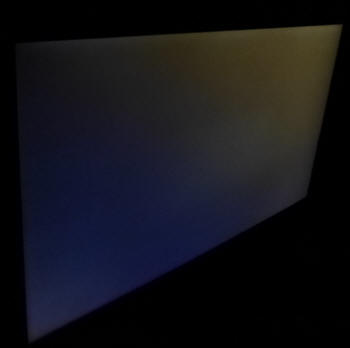
Above: View of an
all black screen from the side. Click for larger version
On a black image there is a moderate pale grey
tint introduced to the image when viewed from a wide angle. This isn't too
severe and shouldn't present any real problems in practice. Certainly not the
obvious white glow you get from most modern IPS-type panels in similar
situations and fairly standard for a TN Film panel. Very similar to what we have
seen from other recent gaming TN Film screens like the
Asus MG248Q,
Asus ROG Swift PG278Q and
BenQ XL2730Z. The glow you see from most modern IPS panels can put off some
users. So on the one hand, those IPS models have much better general viewing
angles than the TN Film models, but they do show more glow which some people
find an issue.

Panel Uniformity
We wanted to test
here how uniform the brightness was across the screen, as well as identify any
leakage from the backlight in dark lighting conditions. Measurements of the
luminance were taken at 36 points across the panel on a pure white background.
The measurements for luminance were taken using BasICColor's calibration
software package, combined with an X-rite i1 Display Pro colorimeter with a
central point on the screen calibrated to 120 cd/m2. The below
uniformity diagram shows the difference, as a percentage, between the
measurement recorded at each point on the screen, as compared with the central
reference point.
It is worth
noting that panel uniformity can vary from one screen to another, and can depend
on manufacturing lines, screen transport and other local factors. This is only a
guide of the uniformity of the sample screen we have for review.

Uniformity of Luminance
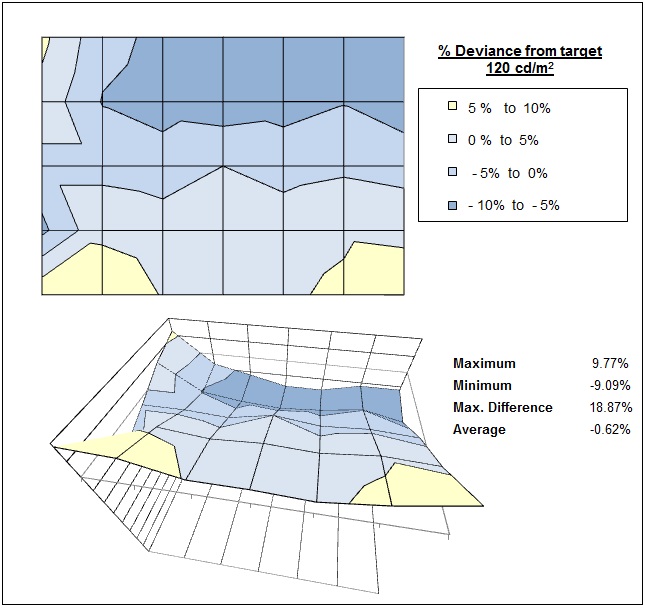
The luminance uniformity of the screen was
reasonably
good overall. The screen was brighter
towards the bottom edge than at the top, so there was a fair difference if
you compare the two extremes, but it was more subtle between the top/bottom
and the central area of the panel. In the worst case the luminance dropped
to 110
cd/m2
(-9%). Actually, 100% of the screen was within a 10% deviance from the
centrally calibrated point which was decent.

Backlight Leakage
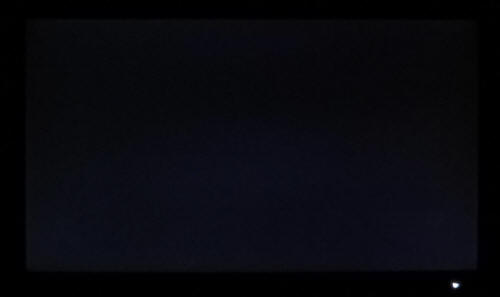
Above: All black screen in a darkened room. Click for larger version
We also tested the screen with an all black image
and in a darkened room. A camera was used to capture the result. The camera
showed there was no real backlight bleed evident, but a little clouding from the
bottom edge of the screen where we know the luminance was a little higher than
the upper areas.
Note: if you want to test your own screen for
backlight bleed and uniformity problems at any point you need to ensure you have
suitable testing conditions. Set the monitor to a sensible day to day brightness
level, preferably as close to 120
cd/m2 as you can get it (our tests are
once the screen is calibrated to this luminance). Don't just take a photo at the
default brightness which is almost always far too high and not a realistic usage
condition. You need to take the photo from about 1.5 - 2m back to avoid
capturing viewing angle characteristics, especially on IPS-type panels where
off-angle glow can come in to play easily. Photos should be taken in a darkened
room at a shutter speed which captures what you see reliably and doesn't
over-expose the image. A shutter speed of 1/8 second will probably be suitable
for this.

General and Office Applications
With a 1920 x 1080 resolution, the desktop real
estate of the AG251FZ feels a step down compared with all the high resolution
panels we've tested, and the 27" 2560 x 1440 models we are used to using day to
day. You do lose a large amount of desktop space, and although side by side
split screen working is possible, it's not as easy due to the more limited
resolution and space. With a 0.2825mm pixel pitch, text is comfortable and easy
to read natively, providing a sharp and crisp image. It is not as sharp as the
1440p panels we've become accustomed to, or of course any ultra HD/4K
resolutions where scaling is used, but it is perfectly adequate. For this size
screen, 1920 x 1080 is about your limit of sensible resolution without needing
to use operating system scaling options.
The moderate AG coating of the TN Film panel could
be considered a bit grainy, especially on white office backgrounds to a lot of
people. It's not as clear as modern IPS coatings or any semi-glossy solution.
Still, it's not as grainy as old IPS panels and is on par with other TN Film
matrices we've tested. Perhaps the main issue with this panel technology though
is the restrictive viewing angles, making contrast and colour tone shifts a bit
of a problem when it comes to colour critical work. They are the same here as
other TN Film panels, being restrictive especially vertically. The screen is
fine when viewed head on though really for office and text work, but for colour
critical work or photo editing etc you'd be better off with an IPS-type panel.
The default setup of the screen was a bit restrictive for normal uses, as the
gamma is set up more for gaming, but thankfully this was very easy to adjust
without a calibration tool via a simple change in the OSD menu. That provided a
good default setup then for day to day office work, once you've turned the
brightness setting down. There are 3 blue light filter modes (weak, medium and
strong) offered in the menu if you want to add further eye care protection and
might be worth experimenting with for prolonged office use or text reading.
The brightness
range of the screen was very good, with the ability to offer a luminance between
366 and 58 cd/m2. This should mean the screen is perfectly useable in
a wide variety of ambient light conditions, including darkened rooms. A setting
of ~23 in the OSD brightness control should return you a luminance close to 120
cd/m2 out of the box. Otherwise you might want to try the settings
from our
calibration section. On another positive note, the brightness regulation is
controlled without the need for the use of the now infamous
Pulse-Width Modulation (PWM), and so those who suffer from eye fatigue or
headaches associated with flickering backlights need not worry. There was no
audible noise or buzzing from the screen, even when specifically looking for it
using test images with a large amount of text at once. The screen also remains
cool even during prolonged use.
There are quite a
few extra features on this screen for office environments, even though it's
primarily a gaming screen. There are 4 USB ports, including 2 easy access on the
right hand side of the screen and one featuring fast charging support. There's a
mic, headphone and audio out connection along with the integrated stereo
speakers which should be fine for the odd YouTube clip or mp3. There are no
ambient light sensor, card reader, motion sensor or anything else provided which
can sometimes be useful in office environments.
There was a good range of ergonomic adjustments
available from the stand allowing you to obtain a comfortable position for a
wide variety of angles. The VESA mounting support may also be useful to some
people as well.

Responsiveness and Gaming
The AG251FZ is firmly a gamers screen, with key
features including the native 240Hz refresh rate, 1ms G2G response time and
support for AMD FreeSync. You will need to keep in mind the demands on your
system and graphics card to power a screen like this, as there's quite a drain
on resources to run at 240Hz! The resolution is 'only' 1920 x 1080 so that is at
least a bit easier than if this was a 1440p or 4k resolution screen. For systems
which can't manage the 240Hz reliably or frequently, FreeSync is supported for
variable refresh rate control, helping to eliminate tearing and stuttering and
operating in a nice wide range from 48 to 240Hz. AOC
have provided a wide range of
additional extras for gaming that we will talk about in a moment.
|
Quoted G2G Response Time |
1ms G2G |
|
Quoted ISO Response Time |
n/a |
|
Panel Manufacturer and
Technology |
AU Optronics TN Film |
|
Panel Part |
M250HTN0.1 |
|
Overdrive Used |
Yes |
|
Overdrive Control Available to
User |
Overdrive |
|
Overdrive Settings |
off, weak, medium, strong |
The AGON AG251FZ is rated by AOC as having a 1ms G2G
response time which indicate the panel uses
overdrive /
response time compensation (RTC) technology to boost pixel transitions
across grey to grey changes. The
part
being used is the
AU Optronics M250HTN01.0 TN Film technology panel. Have a read about response time in
our
specs section if you need additional information about this measurement. As
a reminder, this is the first native 240Hz refresh rate panel of any size and
type we have seen.

We will first test the screen using our thorough
response time testing method. This uses an oscilloscope and photosensor to
measure the pixel response times across a series of different transitions, in
the full range from 0 (black) to 255 (white). This will give us a realistic view
of how the monitor performs in real life, as opposed to being reliant only on a
manufacturers spec. We can work out the response times for changing between many
different shades, calculate the maximum, minimum and average grey
to grey (G2G) response times, and provide an evaluation of any overshoot present
on the monitor.
We use an
ETC M526
oscilloscope for these measurements along with a custom photosensor device.
Have a read of
our response time measurement article for a full explanation of the testing methodology and reported
data.

Overdrive Setting

The 'overdrive' control is available via the 'game
setting' section of the OSD menu as shown above. We will test all four modes to
see which is optimal first of all. Note that these results were basically the same from an NVIDIA and AMD test system. For now we have taken these measurements at the maximum 240Hz refresh rate, but we will look at the
implications of the refresh rate in a moment once we've
established the behaviour of the response times under this setting.




In the 'off' setting the response times were
mixed, with some around the advertised 1ms G2G figure, but many being much
slower up around 9 - 13ms. There was no overshoot as you would expect with
overdrive turned off, but the response times were slower than we would like from
a TN Film panel. Turning the overdrive up to 'weak' brought about some minor
improvements, reducing the average figure from 8.3ms to 7.2ms. There was again
an improvement as you moved up to 'medium', dropping the average response time
to 5.9ms, and still without any sign of overshoot. At the maximum 'strong'
setting, response times were improved significantly, down to 2.7ms G2G now. Some
moderate overshoot was starting to creep in, but on par with most fast TN Film
gaming screens we've seen, so nothing too severe. The optimal overdrive setting
will be between medium and strong, and we will consider which is best when we
look at the refresh rate impact in a moment.

Refresh Rate and FreeSync
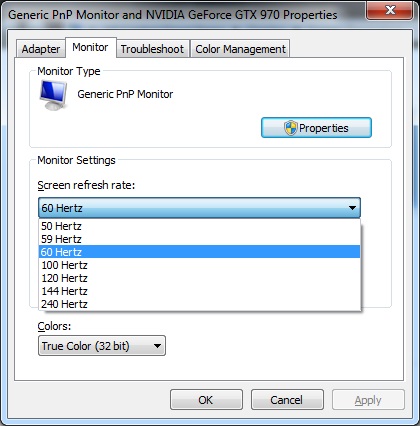
The AG251FZ supports a refresh rate of up to 240Hz
natively, and as we've discussed earlier this is the first panel supporting such
a high refresh rate on the market. You can quickly and easily select this
refresh rate in Windows as shown above, although we did find we had to use the
provided DisplayPort cable rather than our regular day to day cable, so perhaps
it is a little fussy on the cabling choice. Just stick with the one provided and
you will be fine. When enabled, and from a compatible system, FreeSync is
also available which operates in a range between 48 and 240Hz. There are
improvements in perceived motion clarity as you increase the refresh rate, and
the 240Hz certainly feels more fluid and faster than 120 / 144Hz. The
improvement is not as noticeable as when you move from 60 to 120Hz for the first
time, but the ability to deliver even higher frame rates from 144 - 240Hz is
certainly welcome.
From an AMD test system we found stable performance without any
frames being dropped at all refresh rates from 60Hz to 240Hz which was good
news. From an NVIDIA system we had some issues at the maximum 240Hz refresh rate
(not at anything lower), where some frames were being dropped. This display is
clearly aimed at AMD users anyway and so that might explain the incompatibility
there for NVIDIA when you push the boundaries of the refresh rate. We've asked
AOC for comment nonetheless.
Refresh Rate Impact, Overdrive Mode = Strong
We stuck to the 'strong' overdrive setting for now
and we wanted to test the response times at a range of refresh rates to see if
that influences the pixel transitions. It's quite common for the overdrive
impulse to be dynamically controlled across a wide refresh rate range like this.
The overshoot can also be impacted we have seen in the past.



As you can see from these measurements the actual
pixel transition times do not seem to really change that much overall as you
change the refresh rate. We measured basically the same average response time of
around 2.5 - 2.7ms G2G across each refresh rate from 60 to 240Hz, while sticking with
the same 'strong' overdrive setting in the menu. What did change though was the
levels of overshoot, which improved as you increased the refresh rate. So at
60Hz there were high levels of overshoot detected on a wide
range of transitions, but as you reached 144Hz and then 240Hz a lot of the overshoot
was eliminated or reduced. This is good news of course, but you need to be achieving a high
refresh rate really to be able to experience the screen without the overshoot
becoming an issue in this 'strong' mode.
We will look in a moment at the lower 'medium'
setting to see how refresh rate impacts response times/overshoot there, as for
those using the screen at lower refresh rates it might well be more optimal than
this aggressive 'strong' mode.
Optimal Overdrive Setting at 240Hz = Strong


If we compare above the response time performance
at 240Hz in the 'strong' mode, vs. the next step down in the 'medium' mode we
can see that really to support the 240Hz refresh rate effectively, you need to
stick to the 'strong' mode. To handle the high frame rate of 240Hz, response
times needs to be reliably and consistently under 4.17ms (1000 / 240 = 4.17),
otherwise you will get additional blurring and smearing where response times
cannot keep up with the frame changes. In the 'medium' setting, the response
times are too slow to really support 240Hz refresh rate, and in practice you
will see some added smearing to a moving image. The 'strong' setting supported
240Hz well, with an average G2G figure of 2.7ms measured. As we discussed above,
the overshoot at this max refresh rate was moderate but not too severe. So if
you want to enjoy the screen at the maximum 240Hz setting, and can reliably
achieve the frame rates to make this worthwhile, then stick to the 'strong'
setting.
Optimal Overdrive Setting at Less than 240Hz
= Medium



We know that the 'strong' overdrive mode is
optimal if you're achieving the 240Hz maximum refresh rate of this screen, but
at lower refresh rates the overshoot starts to become too distracting and
severe. Thankfully, the 'medium' overdrive setting is far less aggressive and
shows no overshoot at all at any refresh rate. The response times remains fairly
consistent as well across the refresh rate range, actually getting a little
slower as you increase the refresh. It looked from the 'strong' setting that
maybe the overdrive impulse was being turned down a little as you increased
refresh rate, which accounts for the improvements we saw in levels of overshoot.
Maybe the same is true here, where the overdrive impulse is turned down ever so
slightly as you increase refresh rate and so response times slow a little. It's not enough to make any real
difference anyway, and in fact the improvements you get in perceived motion
clarity from the increased frame rate easily out-weigh anything you might see
from slightly slower pixel transition times.
So at all refresh rates there is no visible
overshoot in this 'medium' overdrive mode. Given the average G2G response times
are around 5.2 - 5.9ms G2G we can estimate that in theory, refresh rates up to
around 175Hz are achievable in this overdrive mode, before additional smearing
starts to become an issue. So if you're using FreeSync and managing to deliver
in the 48 - 175Hz range, this 'medium' mode will be adequate and will avoid any
noticeable overshoot. At the top end if you're achieving from 175 - 240Hz you'd
probably be best to switch to the 'strong' mode, which brings response times
down to avoid any additional smearing, but introduces some moderate (but
manageable) overshoot. Obviously for any console gaming (60Hz) or fixed refresh
rate from 60 - 144Hz away from FreeSync use, you're better with the 'medium'
setting.

Detailed Response Time Measurements
Refresh
Rate = 240Hz, Overdrive = Strong
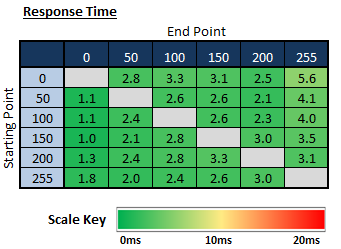 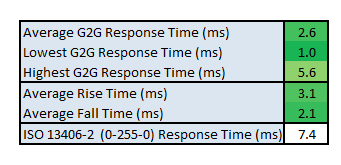
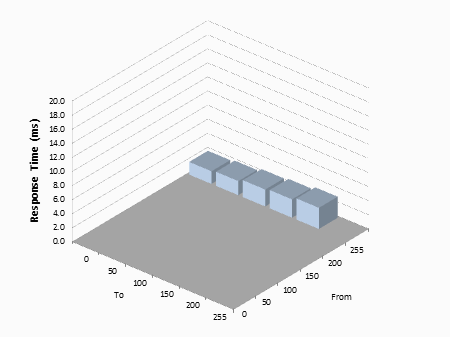
We stuck with what we consider to be the optimal 'strong'
response time setting at the maximum 240Hz refresh rate. The
average G2G response time was measured at 2.6ms which was very good and
represented very fast pixel transition times from this new TN Film panel. Some
transitions reached as low as the advertised 1ms G2G as well.
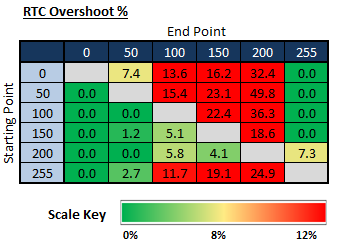
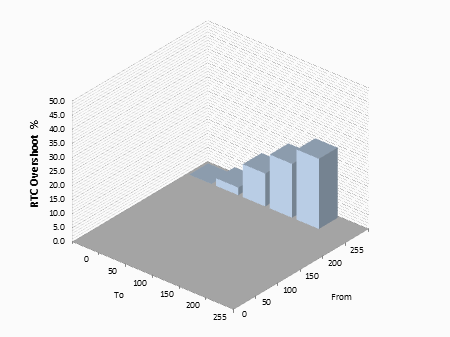
If we evaluate the Response Time Compensation
(RTC) overshoot then the results show moderate to high levels here in this
'strong' mode. That is not dissimilar to most fast TN Film gaming screens and
it's not overly obvious in practice due to the high frame rate and smooth motion
clarity. You can eliminate the overshoot completely if you revert to the
'medium' overdrive setting, but that will only really support refresh rates up
to around 175Hz reliably without additional smearing starting to appear.

Display Comparisons
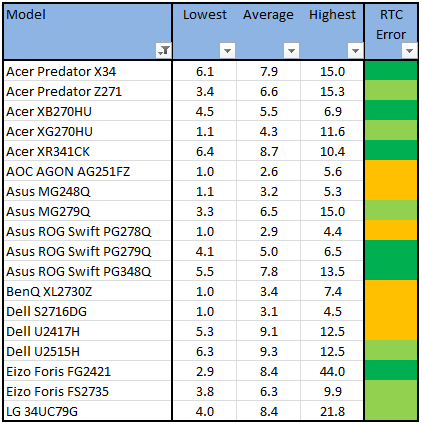
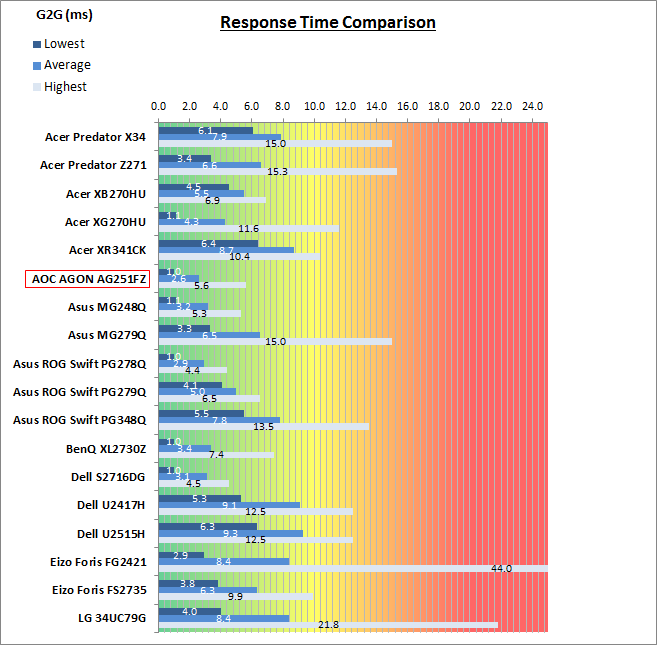
The above comparison table and graph shows you the
lowest, average and highest G2G response time measurement for each screen we
have tested with our oscilloscope system. There is also a colour coded mark next
to each screen in the table to indicate the RTC overshoot error, as the response
time figure alone doesn't tell the whole story.
As a reminder, these figures are at 240Hz refresh
rate and with overdrive set to 'strong'. The response time performance of the
AG251FZ was very impressive overall, with actually the fastest response times
we've measured from any gaming screen at 2.6ms G2G. Other fast TN Film screens
are very close of course, like the Asus ROG Swift PG278Q (2.9ms) and Dell
S2716DG (3.1ms) for instance. There is a boost here on the AOC with frame rate
support, pushing quite a long way beyond the 144Hz supported from those other
models mentioned. If your system can support it, then the 240Hz does bring about
obvious advantages in frame rate and motion clarity. There is moderate levels of
lag on these ultra-fast TN Film screens which you have to live with to drive the
response times as low as they are.

Pursuit Camera Tests
(updated)
We've already tested above the actual
pixel
response times and other aspects of the screen's gaming performance. We
wanted to carry out some pursuit camera tests as well to give an even more
complete idea of the performance of this screen.
Pursuit cameras are used to capture motion blur as
a user might experience it on a display. They are simply cameras which follow
the on-screen motion and are extremely accurate at measuring motion blur,
ghosting and overdrive artefacts of moving images. Since they simulate the eye
tracking motion of moving eyes, they can be useful in giving an idea of how a
moving image appears to the end user. It is the blurring caused by eye
tracking on continuously-displayed refreshes (sample-and-hold) that we are keen
to analyse with this new approach. This is not pixel persistence caused by
response times; but a different cause of display motion blur which cannot be
captured using static camera tests. Low response times do have a positive impact
on motion blur, and higher refresh rates also help reduce blurring to a degree.
It does not matter how low response times are, or how high refresh rates are,
you will still see motion blur from LCD displays under normal operation to some
extent and that is what this section is designed to measure. Further
technologies specifically designed to reduce perceived motion blur are required
to eliminate the blur seen on these type of sample-and-hold displays which we
will also look at.
We used the
Blurbusters.com Ghosting Motion Test which is designed to be used with
pursuit camera setups. The pursuit camera method is
explained at BlurBusters
as well as
covered in this research paper. We
carried out the tests at various refresh rates, with and without Blur Reduction enabled.
These UFO objects were moving horizontally at 960 pixels per second, at a frame
rate matching refresh rate of the monitor.
Overdrive Setting
= Medium
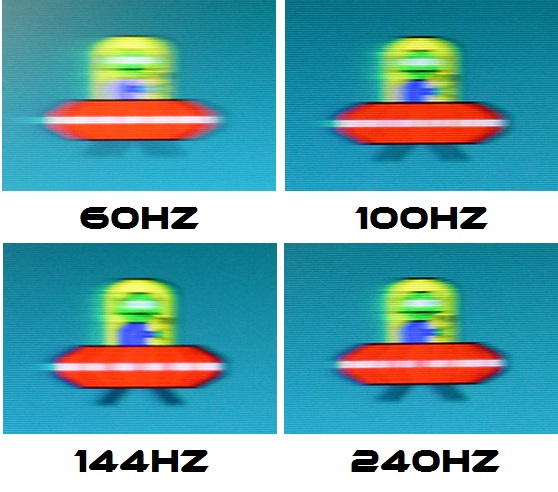
These tests capture the kind of blurring you would
see with the naked eye when tracking moving objects across the screen. As you
increase the refresh rate the perceived blurring is reduced, as refresh rate has
a direct impact on motion blur.
It is not
eliminated entirely due to the nature of the sample-and-hold LCD display and the
tracking of your eyes.
No matter how fast the refresh rate and pixel
response times are, you cannot eliminate the perceived motion blur without other
methods like blur reduction strobing backlights, which this model does not
feature.
As you can see, the perceived motion clarity
improves significantly as you increase the refresh rate from 60 to 100 and 144Hz
levels. The moving image becomes easier to track and appears sharper. With the
overdrive setting at 'medium' here, at the maximum 240Hz refresh rate you will
notice a slightly more smeared and blurry image. While the refresh rate is
increased significantly, the response times in this setting are not quite fast
enough to keep up with the frame rate demands
as
measured in our previous section. As a result, you get a little additional
smearing introduced on the moving image. There is no overshoot at any of these
refresh rates when using the 'medium' overdrive option.
Overdrive Setting
= Strong
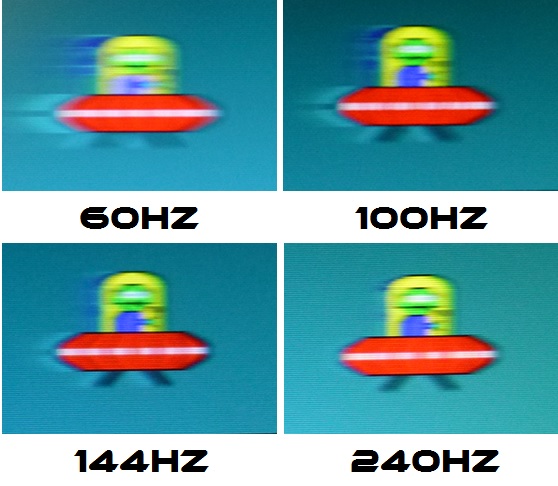
Switching up to the 'strong' overdrive setting
showed similar results in terms of improved motion clarity as you increase the
refresh rate. Again, the moving image became clearer and sharper. At the maximum
240Hz refresh rate here, the response times were fast enough to keep up with the
high frame rate and so you don't get any added smearing like you do at the
'medium' overdrive setting. There is a large amount of overshoot at lower
refresh rates as we've already discussed
earlier
in the review, but it becomes progressively less as you increase refresh
rate. By the maximum 240Hz refresh rate the overshoot is only moderate and hard
to notice in many cases. As we said earlier in the review, if you're achieving
somewhere around 175 - 240Hz refresh rate then the 'strong' overdrive mode is
optimal. For 48 - 175Hz then you'd probably be better sticking with the 'medium'
mode.
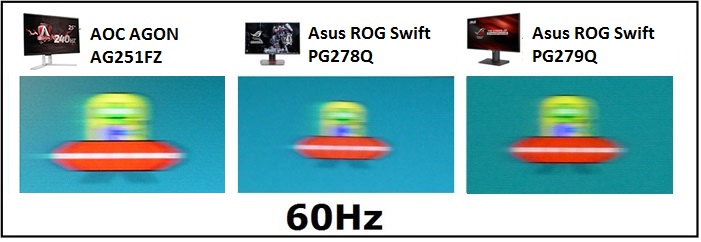
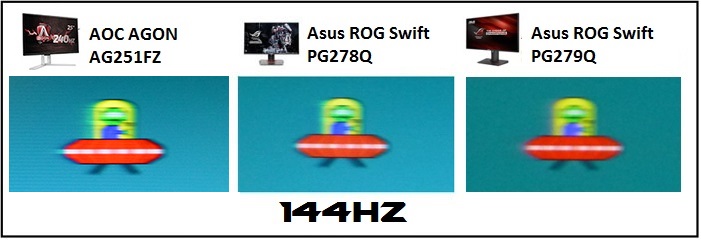
Note: optimal
overdrive settings used on each screen
We can also compare the pursuit camera tests at
60Hz and 144Hz compared with a couple of very fast and very popular gaming
screens above. The performance is very comparable in actual perceived motion
blur between all three in practice, with very little to separate them. The TN
Film PG278Q and AG251FZ models feel ever so slightly more fluid we felt, thanks
to the slightly faster response times.
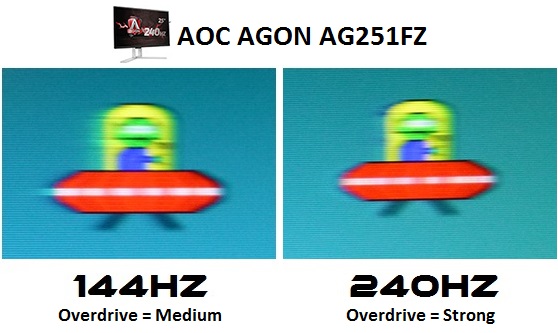
The good thing about the AG251FZ is that you can
then also boost the refresh rate up higher than 144Hz, offering additional
motion clarity benefits and a massively increased frame rate. This does make a
difference in practice.

Additional Gaming Features

Aspect Ratio Control -
the AG251FZ has a wide range of options for
aspect ratio control through the OSD 'extra' menu as shown above. There
are options for (wait for it!): 1:1 pixel mapping, 17" (4:3), 19" (4:3), 19"
(5:4), 19"W (16:10), 21.5"W (16:9), 22"W (16:10), 23"W (16:9), 23.6"W (16:9),
24" (16:9) and 'wide'. Each of the specified size options is designed to mimic
the screen size visible from each, although we're not entirely sure for what
purpose, unless you were maybe trying to match the screen size with another
display? Anyway, there was a good range of options and importantly 1:1 is
available which will cover many non-16:9 needs we are sure.

Shadow Control -
There is a shadow control slider available in the
'game setting' menu and also via the quick access option from the OSD
buttons/switch accessory (pressing the right arrow). This alters the gamma
levels quickly and easily which might be useful for different gaming scenarios.
Game Color-
This operates like a digital vibrance control,
boosting the colours (or dulling them) which some users might like for their
gaming.

Preset Modes -
There are several specific game preset modes
available from the 'game setting' menu. There are three preset modes for FPS,
RTS and racing games. In those, you can change some settings yourself although
some (including overdrive) are greyed out. There are then 3 gamer preset modes
where you can change the settings manually for each in the 'game setting' menu
(including overdrive now). Oddly you can't access the 'color setup' menu when
you're using any of these gaming presets and also they seem to have a slightly
boosted and accentuated sharpness added, for which there is no control in the
OSD anyway! Still, they are useful if you want to set up different options
for different gaming scenarios including perhaps altering the 'game color' and
'shadow control' options. The 3 gamer preset modes are accessible quickly and
easily via the switch accessory too which is useful.

Lag
We have written an in depth article about
input lag and the various measurement techniques which are used to evaluate
this aspect of a display. It's important to first of all understand the
different methods available and also what this lag means to you as an end-user.
Input Lag vs. Display Lag vs. Signal
Processing
To avoid confusion with different terminology we
will refer to this section of our reviews as just "lag" from now on, as there
are a few different aspects to consider, and different interpretations of the
term "input lag". We will consider the following points here as much as
possible. The overall "display lag" is the first, that being the delay between
the image being shown on the TFT display and that being shown on a CRT. This is
what many people will know as input lag and originally was the measure made to
explain why the image is a little behind when using a CRT. The older stopwatch
based methods were the common way to measure this in the past, but through
advanced studies have been shown to be quite inaccurate. As a result, more
advanced tools like SMTT provide a method to measure that delay between a TFT
and CRT while removing the inaccuracies of older stopwatch methods.
In reality that lag / delay is caused by a
combination of two things - the signal processing delay caused by the TFT
electronics / scaler, and the response time of the pixels themselves. Most
"input lag" measurements over the years have always been based on the overall
display lag (signal processing + response time) and indeed the SMTT tool is
based on this visual difference between a CRT and TFT and so measures the
overall display lag. In practice the signal processing is the element which
gives the feel of lag to the user, and the response time of course can
impact blurring, and overall image quality in moving scenes. As people become
more aware of lag as a possible issue, we are of course keen to try and
understand the split between the two as much as possible to give a complete
picture.
The signal processing element within that is quite
hard to identify without extremely high end equipment and very complicated
methods. In fact the studies by Thomas Thiemann which really kicked this whole
thing off were based on equipment worth >100,1000 Euro, requiring extremely high
bandwidths and very complicated methods to trigger the correct behaviour and
accurately measure the signal processing on its own. Other techniques which are
being used since are not conducted by Thomas (he is a freelance writer) or based
on this equipment or technique, and may also be subject to other errors or
inaccuracies based on our conversations with him since. It's very hard as a
result to produce a technique which will measure just the signal processing on
its own unfortunately. Many measurement techniques are also not explained and so
it is important to try and get a picture from various sources if possible to
make an informed judgement about a display overall.
For our tests we will continue to use the SMTT
tool to measure the overall "display lag". From there we can use our
oscilloscope system to measure the response time across a wide range of grey to
grey (G2G) transitions as recorded in our
response time
tests. Since SMTT will not include the full response time within its
measurements, after speaking with Thomas further about the situation we will
subtract half of the average G2G response time from the total display lag. This should allow us to give a good estimation of
how much of the overall lag is attributable to the signal processing element on
its own.
Lag Classification
To help in this section we will also introduce a broader classification system
for these results to help categorise each screen as one of the following levels:
-
Class 1)
Less than 16ms / 1 frame of lag at 60Hz - should be fine for gamers, even at high levels
-
Class
2)
A lag of 16 -
32ms / One to two frames - moderate lag but should be fine for many gamers.
Caution advised for serious gaming and FPS
-
Class
3)
A lag of more
than 32ms / more than 2 frames - Some noticeable lag in daily usage, not
suitable for high end gaming
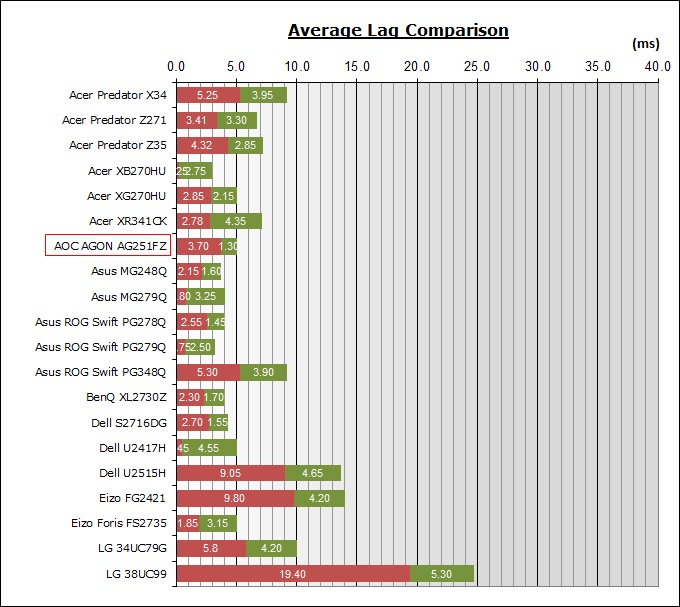
For the full reviews of the models compared here and the dates they were written
(and when screens were approximately released to the market), please see our
full
reviews index.
|
|
Low Input Lag Mode |
|
(Measurements in ms) |
Off |
On |
|
Total Display Lag (SMTT
2) |
13.5 |
5.0 |
|
Pixel Response Time
Element |
1.3 |
1.3 |
|
Estimated Signal
Processing Lag |
12.2 |
3.7 |
|
Lag Classification |
1 |
1 |
|

Class
1 |
We have provided a comparison above against other
models we have tested to give an indication between screens. The screens
tested are split into two measurements which are
based on our overall display lag tests (using SMTT) and half the average G2G
response time, as measured by the oscilloscope. The response time is split from
the overall display lag and shown on the graph as the green bar. From there, the
signal processing (red bar) can be provided as a good estimation.
The screen features a 'low input lag' mode option
in the menu. First of all we tested the screen with this turned off. This showed
a total average display lag of 13.5 ms as measured with SMTT 2. Taking into
account half the average G2G response time at 1.3ms, we can estimate that there
is ~12.2ms of signal processing lag on this screen which pretty low anyway.
Switching the low input lag mode on returned improved results, with an estimated
3.7ms of signal processing lag now instead. This represents a very low lag which
shouldn't represent any problems in gaming.
One annoyance with this was when you're connected
to a FreeSync system. As with most FreeSync screens we've tested, the screen
seems to always think you are operating with FreeSync, even if you disable the
option in the AMD graphics card software. We believe this is a known bug and in
many cases it doesn't really cause any issue. You can tell that is happening
here as in the OSD menu the vertical refresh rate is listed as "FreeSync",
regardless of whether you've enabled the option in the graphics card control
panel. The issue with this though is that when FreeSync is active (or even not
active, but detected), the 'low input lag' option is greyed out and not
accessible. So from a FreeSync system you will have to live with the slightly
higher lag, although this is still very low really and shouldn't represent any
major issues. We've asked AOC if there is a reason why this option is greyed out
when using FreeSync and will update this section accordingly when we have more
info.

Movies and Video

The following summarises the screens performance
in video applications:
-
24.5"
screen size makes it a reasonable option for an all-in-one multimedia screen,
but being quite a lot smaller than most modern LCD TV's of course.
-
16:9
aspect ratio is more well suited to videos than a 16:10 format screen, leaving
smaller borders on DVD's and wide screen content at the top and bottom.
-
1920 x
1080 resolution can support full 1080 HD resolution content
-
Digital interfaces support HDCP for any encrypted and protected content
-
Good range of connectivity options provided
with DisplayPort, 2x HDMI, Dual-link DVI and VGA offered.
-
Cables provided in the box
for all video
connections
-
Moderate AG coating provides reasonably clear images with no major graininess,
and without the unwanted reflections of a glossy solution. Some graininess
apparent as with other TN Film panels, but shouldn't present a problem in
movies.
-
Wide
brightness range adjustment possible from the display, including a maximum
luminance of ~366
cd/m2 and a decent minimum luminance
of 58 cd/m2. This should afford you good control for different
lighting conditions. Contrast ratio remains stable across that adjustment
range as well and is good for a TN Film panel. Brightness regulation is
controlled without the need for PWM and so is flicker free for all brightness
settings.
-
Black
depth and contrast ratio are good for a TN Film panel at 931:1 after
calibration. Detail in darker scenes should not be lost as a result.
-
There
is no specific 'movie' preset mode available for movies or video but you could
easily set up one of the 3 customisable gamer modes if you want for movie
viewing
-
Very
good pixel responsiveness which will handle fast moving scenes in movies
without issue. You will want to stick with the 'medium' overdrive mode to
avoid any overshoot issues present in the 'strong' mode. Certainly when using
an external Blu-ray player operating at 60Hz.
-
Viewing angles are limited due to the use of TN Film panel technology. May
cause issues with gamma and contrast shift if you change your line of sight or
have several people trying to see the screen at once. Not really an ideal
technology for movies as a result of this viewing angle limitation.
-
Very good and mostly easy to use range of
ergonomic adjustments available from the stand, so should be easy to obtain a
comfortable position if you want to sit further away from the screen for movie
viewing.
-
No
particularly noticeable backlight leakage, and none from the edges which is
good. This type of leakage may prove an issue when watching movies where black
borders are present but it is not a problem here.
-
2x 3W
integrated stereo speakers on this model for the occasional movie clip and
YouTube video, but probably not suitable for movie viewing. There is also an
audio output and headphone jack connection if needed.
-
Good
range of hardware aspect
ratio options including various defined screen sizes and aspect ratios, along
with 'wide' and 1:1 pixel mapping which should be fine for most uses. The
screen is natively 16:9 which should be fine for external devices anyway
-
Picture in picture (PiP) and Picture By Picture (PbP) are not available.

Conclusion
If you appreciate this review and enjoy reading and like our work, we would welcome a
donation
to the site to help us continue to make quality and detailed reviews for you.
The AG251FZ was the first 240Hz native refresh
rate screen we've tested and it delivered very well when it came to its primary
focus of gaming. The additional boost in frame rate and motion clarity were
decent and extends the possibilities for high frame rate gaming from LCD screens
by a significant amount. Thankfully the TN Film panel offers very fast response
times which can keep up with the refresh rate demands, unlike some other panel
technologies we've seen where they struggle -especially where overclocked
refresh rates are introduced. The addition of AMD FreeSync will be very useful
for those who can't power the 240Hz at 1080p consistently and this is so far the
only FreeSync option in this space with 240Hz support. There was a very good
range of additional gaming features and options in the menu, and we liked the
included switch accessory which made changing options much simpler and quicker.
There is a useful low input lag option as well
which worked well at reducing the already pretty low lag of the screen.
Unfortunately this didn't seem to be available when using a FreeSync system
which was a shame, but don't be put off as the lag is still not bad even without
it. We would have liked to see an added blur reduction backlight option if we
were being picky, but that would have presumably added to the retail cost, and
most people will probably want to use FreeSync anyway given the wide refresh
rate range and demands on your system pushing anywhere near the 240Hz.
In other areas the screen had a decent out of the
box setup once you made a simple change to the gamma mode, and we were pleased
with the flicker free backlight and wide backlight adjustment range. You will
have to live with some of the inherent limitations of TN Film technology, most
notably the restrictive viewing angles so just be aware of that. There is a very
good range of connections and stand features, and the additional easy access
connections on the side of the screen were handy. It's a well thought out screen
with plenty of extras and features, and certainly a very interesting option for
gamers.
|
Pros |
Cons |
|
Excellent gaming performance
with very fast response times, up to 240Hz refresh rate and FreeSync
support |
Limitations of TN Film
technology when it comes to viewing angles particularly |
|
Nice range of connections and
extra features |
Would have been nice to see a
blur reduction backlight included |
|
Good default setup available
with simple OSD change |
Low input lag mode doesn't
seem to work from FreeSync systems |
|
Check Pricing and Buy - Direct Links
|
|
Amazon
|
|
TFTCentral is a participant
in the Amazon Services LLC Associates Programme, an affiliate
advertising programme designed to provide a means for sites to earn
advertising fees by advertising and linking to Amazon.com, Amazon.co.uk,
Amazon.de, Amazon.ca and other Amazon stores worldwide. We also
participate in a similar scheme for Overclockers.co.uk. |
|